Skin Cancer
Conveniently located to serve Nashua, NH
What is skin cancer?
Skin cancer is an abnormal growth of skin cells. It most often develops on areas of the skin exposed to the sun’s rays and is mostly commonly found on the face, arms, hands and legs. Skin cancer affects people of all colors and races, although those with light skin who sunburn easily have a higher risk.
What does skin cancer look like?
Actinic Keratoses (AK)
These dry, scaly patches or spots are precancerous growths that have the potential to evolve into squamous cell carcinoma if left untreated. They often present as a pink, scaly or crusted, flat or raised area on the skin. They are often described as an area of skin that continually flakes and feels a little sensitive to the touch.



Basal cell carcinoma (BCC)
This is the most common type of skin cancer.
BCCs look like flesh-colored, pearly bumps or a pinkish, scaly patch of skin. They can sometimes crust and bleed. BCCs develop after years of frequent sun exposure or indoor tanning. BCC is common on the head, neck, and arms, yet can form anywhere on the body, including the chest, abdomen, and legs. Early diagnosis and treatment for BCC is important. BCC can invade the surrounding tissue and grow into the nerves and bones, causing damage and disfigurement. There are several treatment options available depending on the aggressiveness of the BCC. Treatments can include topical chemotherapy cream, electrodessication and curettage (scraping and mild burning), and local excision (surgical removal).

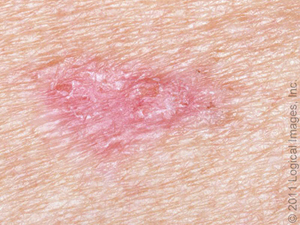
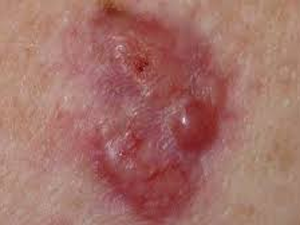
Squamous cell carcinoma (SCC)
SCC is the second most common type of skin cancer.
SCC often looks like a red firm bump, scaly patch, or a sore that doesn’t heal. They can even present as crusted looking horns. SCC tends to form on skin that gets frequent sun exposure, such as the rim of the ear, face, neck, arms, chest, and back. SCC can grow deep in the skin and cause damage to underlying tissues and disfigurement. Unlike BCC, SCC has a higher potential to spread to other areas of the body which is called metastasis. There are treatment options depending on the aggressiveness of the SCC to include topical chemotherapy cream, electrodessication and curettage (scraping and mild burning), and local excision (surgical removal). If metastasis occurs then radiation and chemotherapy may be necessary as it can be fatal.
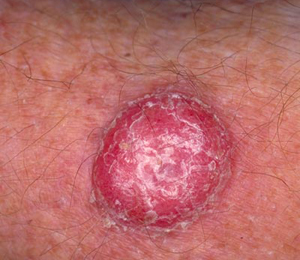
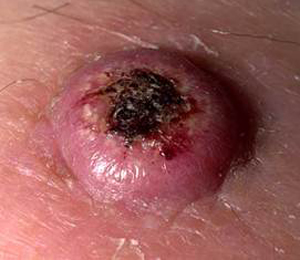
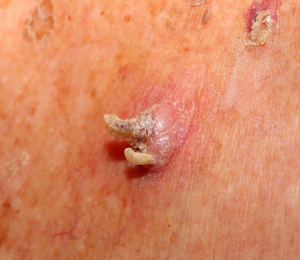
Melanoma
Melanoma is the deadliest form of skin cancer.
Melanoma frequently develops in a mole or suddenly appears as a new dark spot on the skin. Early diagnosis and treatment are crucial as melanoma can start out as a small skin lesion but has the potential to metastasis (spread) to other parts of the body and be fatal. While there are treatments available, to include local excision (surgically remove), radiation, and chemotherapy, early detection is key. Knowing the ABCDE warning signs of melanoma can help you find an early melanoma. Melanoma does have a genetic link and can be inherited.
While Melanoma can present as a new or changing dark spot, there are variants that appear as light brown, pink, and even white colored spots. It is important to see a dermatologist if you are unsure or suspicious about any spots or changes to your skin.

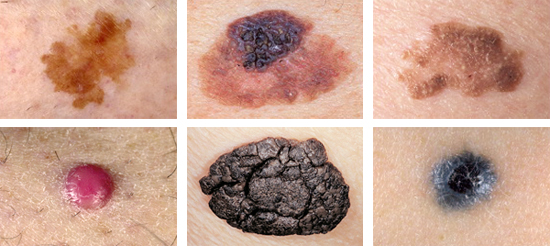
How common is skin cancer?
The incidence of both non-melanoma and melanoma skin cancers has been increasing over the past decades. Currently, between 2 and 3 million non-melanoma skin cancers and 132,000 melanoma skin cancers occur globally each year. One in every three cancers diagnosed is a skin cancer and, according to Skin Cancer Foundation Statistics, one in every five Americans will develop skin cancer in their lifetime.
Who is most at risk of getting skin cancer?
Due to their relative lack of skin pigmentation Caucasian populations generally have a much higher risk of getting non-melanoma or melanoma skin cancers than dark-skinned populations. However, excessive exposure to sunlight can damage all skin types.
Some individual risk factors for skin cancer
- fair skin
- blue, green or hazel eyes
- light-colored hair
- tendency to burn rather than suntan
- history of severe sunburns
- many moles
- family history of skin cancer
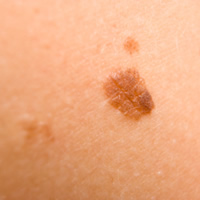 What Are the Symptoms of Skin Cancer?
What Are the Symptoms of Skin Cancer?
A change in your skin is the most common sign of skin cancer. This could be a new growth, a sore that doesn’t heal, or a change in a mole. Not all skin cancers look the same.
How do I lower your skin cancer risk?
- Stay in the shade, especially during mid-day hours of 10:00am and 4:00pm.
- Wear clothing that covers your arms and legs. Darker colors and tightly woven fabrics are best and there are several clothing lines that offer SPF in the fabric for better protection.
- Wear sunglasses that block both UVA and UVB rays.
- Use sunscreen with SPF 30 or higher and both UVA and UVB (broad spectrum) protection.
- Avoid indoor tanning completely.
Sun protective clothing online sites
- http://www.sunprecautions.com
- http://www.columbia.com/technology-omnishade
- http://www.coolibar.com/home.jsp
What is skin cancer screening?
Screening is looking for cancer before a person has any symptoms. This can help find cancer at an early stage. When abnormal tissue or cancer is found early, it can often be easier to treat. By the time symptoms appear, cancer may have begun to spread to other parts of the body.
A provider at Waldman Plastic Surgery and Dermatology will carefully examine your skin in a private setting.
If an area on the skin looks abnormal, a biopsy is usually done. The provider will numb the area and remove as little of the suspicious tissue as possible for accurate diagnosis. The biopsy will then be sent to a lab to be interpreted by a Pathologist who looks at the tissue under a microscope to check for cancer cells.
I was very satisfied with my surgery
I was very satisfied with my surgery. Everyone treated me well and me feel very comfortable.Skin Cancer Patient
When to start skin cancer screenings?
There are no exact, clear cut guidelines on when to start skin cancer screening. However, we recommend that skin cancer screenings start in your 20’s if you have a family history of melanoma. Almost anyone 20 years or older can benefit as skin cancer screenings as early diagnosis can be lifesaving.
Though rare, skin cancer has been found in children. Skin cancer screenings are not standardly performed in children; however, it is appropriate to see a dermatologist if your child has any suspicious lesions for evaluation.
Do I have to see a dermatologist or can my primary doctor do my skin cancer screening?
A Dermatologist is a qualified medical specialist who, through years of specialty training, has obtained qualifications to specialize in the diagnosis, prevention and treatment of skin, nail and hair diseases affecting persons of all ages.
A general practitioner’s practice is not oriented to a specific medical specialty but instead covers a variety of medical problems in patients of all ages.





